浙江理工大学学位论文原创性声明
本人郑重声明:我恪守学术道德,崇尚严谨学风。所呈交的学位论文,是本人在导师
的指导下,独立进行研究工作所取得的成果。除文中己明确注明和引用的内容外,本论文
不包含任何其他个人或集体已经发表或撰写过的作品及成果的内容。论文为本人亲自撰
写,我对所写的内容负责,并完全意识到本声明的法律结果由本人承担。
学位论文作者签名潮汐
日期: 沙.1年专月如日
�
\惝、删,,t 960't 37
浙江理工大学学位论文版权使用授权书
学位论文作者完全了解学校有关保留、使用学位论文的规定,同意学校保留并向国家
有关部门或机构送交论文的复印件和电子版,允许论文被查阅或借阅。本人授权浙江理工
大学可以将本学位论文的全部或部分内容编入有关数据库进行检索,可以采用影印、缩印
或扫描等复制手段保存和汇编本学位论文。
保密IZl
,在
年解密后使用本版权书。
本学位论文属于
不保密√。
学位论文作者签名:柱高毒
日期:劲¨年 3月加日
教
名
乜日丁J指日
:导期
“
签、/雠沪
久3年
如吵
,
日
�
浙江理工大学硕士学位论文
摘要
目前,在频繁发生的交通事故中,驾驶疲劳已成为引发交通事故的重要因素之一。因
此,如何有效地检测和预防驾驶疲劳,对于减少交通事故发生,有着十分重要的现实意义。
在当前的疲劳驾驶检测技术领域,随着科技的不断进步,计算机视觉、图像处理和模
式识别技术得到了进一步的发展和完善。基于驾驶员脸部特征的非接触式疲劳检测算法的
研究和疲劳预警系统的开发已经成为了主流之一。
本文在研究前人工作的基础上,认为夜间是驾驶员疲劳的多发阶段。因此,本文使用
了特殊的红外光源拍摄驾驶员正面面部图象,并根据红外图象所具有的特点提出了一套有
效的驾驶员疲劳检测方法,整个方法分为四个过程:人脸的检测,人脸的跟踪,人眼(瞳
孔)的定位和驾驶员疲劳状态识别。本文具体的研究内容如下:
第一章介绍了驾驶疲劳检测的应用背景以及国内外研究的现状。阐述了疲劳检测研
究的意义,以及论文研究的内容。
第二章提出了红外条件下基于Adaboost人脸检测方法。首先对当前的人脸检测算法进
行分类比较,其次介绍了红外光谱及红外图像的特点。最后,通过AdaBoost目标检测算法
对人脸进行定位,该方法检测效率高,效果好。
第三章提出了改进的Mean.shift人脸跟踪算法。针对Mean—shiit算法在被跟踪目标发生
快速移动时容易跟踪失败的缺点,改进了Mean—shift算法。当目标发生快速移动时,采用SSD
(Sum ofSquare Difference)算法进行全局搜索。以实际驾驶员人脸检测与跟踪实验为例进
行了大量实验,实验结果表明,本文提出的跟踪方法比Mean.shift算法的速度快、准确度高。
第四章提出了红外条件下的的人眼检测和虹膜定位方法。(1)基于约束条件的人眼检
测:首先利用极小值区域进行眼睛的粗定位,然后使用自然约束条件对上述粗定位的眼睛
进行筛选,最后对眼睛进行精确定位;(2)基于Harris的虹膜定位:首先通过二维最大熵
阂值分割方法对眼睛进行阈值分割,然后通过Canny边缘检测的方法提取瞳孔的边缘,运
用Hough变换方法获得瞳孔的位置,最后通过Harris角点检测的方法寻找普尔钦斑点继而
确定虹膜的位置。
第五章提出了红外条件下的驾驶员疲劳检测方法。在驾驶员眼睛精确定位以及虹膜
(普尔钦斑点)精确定位的基础上,分别通过基于PERCLOS钡I量方法以及基于普尔钦光斑的
驾驶员疲劳检测方法对驾驶员疲劳状态进行检测,最后根据驾驶员的眨眼频率及PERCLOS
�
浙江理工大学硕士学位论文
方法对驾驶员的疲劳程度做了一些判断。实验结果表明,效果较好。
第六章总结与展望。对本文主要研究内容做了总结,同时也指出了实验中的不足及
现存的一些问题。最后,对今后的研究做了展望。
关键词:人脸检测;改进的Mean.shift算法;人眼定位;PERCLOS;疲劳检测
H
�
浙江理工大学硕士学位论文
The Study of Fatigue Detection of
Drivers Based on the Infrared Conditions
ABSTRACT
Driver fatigue is one of the important causes in the frequent traffic accidents at present.
Therefore,it is significant to monitor and prevent driver fatigue efficiently for reducing the
tra伍c accidents.
In the current driver fatigue detection field,computer vision,image processing and paRem
recognition technology have been further developed and improved.The research based on driver
facial features,non—contact fatigue detection algorithm and development of fatigue warning
systems have become one of the mainstream.
Based on the research of other people’S work,I think that night is the period when driver
often feel tired.So we get the positive driver images using a special infrared light and develop an
effective driver fatigue detection method in accordance with the characteristics of infrared
images.The whole method is divided into four processes:face detection,tracking ofthe human
face,eye(pupilla)location and driver fatigue recognition.The study ofthis paper is as follows:
In the first chapter,the application background,the current situation of driver fatigue
research and the content of this paper are expounded.
In the second chapter,Adaboost algorithm is used in human face detection and location with
based on infrared conditions.Firstly,comparing the current face detection algorithms,secondly,
introducing the features of infrared spectra and infrared image,and finally AdaBoost target
detection algorithm is used for face detection and location.This method is efficient and effective.
In the third chapter,an improved Mean·shift tracking algorithm is proposed to solve the
poor tracking ability under fast-moving.When the target moves quickly,we use SSD(Sum of
Square Difference)algorithm for global search.By actual face detection and face tracking as
example taken,our method has advantages of quick speed and good accuracy.
In the fourth chapter,there are two methods used for human eyes detection and locmion
based on infrared conditions.(1)eyes detection and location based on restriction:MER(minimum
III
�
浙江理工大学硕士学位论文
extremal region)is introduced here to locate eye roughly;Then the natural constraints is used to
filtrating the eyes step by step;Finally,an accurate eye-locating method is used to adjust the eye
locations precisely,which is used for fatigue detection based on PERCLOS;(2)iris location based
on Harris comer detection algorithm:Firstly,2D maximum entropy threshold segmentation is
used for segmentation of the eyes;Then Canny edge detection method is used for extracting the
edge of the pupil;Finally,using Hough transform to obtain the position of the pupil,and through
the Harris corner detection method to find Purkinje spots and then determine the location of the
iris,which is used for fatigue detection based on Purkinje spot.
In the fifth chapter,we proposed driver’S fatigue detection based on infrared conditions.On
the basis of precise location of the driver's eyes and the iris(Purkinje spots),respectively,the
combination of PERCLOS-based measurement and Purkinje-spot are used serially for detecting
the driver’S fatigue,the experimental results shows that there is good accuracy.
In the sixth chapter,we summarize the main content of our paper.And the objectification
research of fatigue detection of driver is prospected.
KEY WORDS:human face detection;improved Mean-shift algorithm;human eyes
location;PERCLOS;fatigue detection
IV
�
浙江理工大学硕士学位论文
目 录
摘 要
ABSTRACT
第一章绪论………………………………………………………………………………………1
1.1课题研究的背景和意义……………………………………………………………………………….1
1.2国内外驾驶疲劳检测的研究现状……………………………………………………………………2
1.2.1国外研究现状…………………………………………………………………………………………………。2
1.2.2国内研究现状……………………………………………………………………………………………………7
1.3本文的主要研究内容………………………………………………………………………k………8
第二章基于红外条件下的人脸检测及定位………………………………………………….10
2.1人脸检测的方法………………………………………………………………………………………..10
2.1.1基于统计学习的人脸检测方法………………………………………………………………………………lO
2.1.2基于知识建模的人脸检测方法……………………………………………………………………………….11
2.1.3红外条件下的人脸检测………………………………………………………………………………………。1l
2.1.4各种方法的比较………………………………………………………………………………………………12
2.2红外光谱与红外图像的特点……………………………………………………………………….13
2.2.1红外光谱简介…………………………………………………………………………………………………13
2.2.2红外图像的特点………………………………………………………………………………………………14
2.3红外条件下基于AdaBoost的人脸检测方法………………………………………………………15
2.3.1 AdaBoost算法………………………………………………………………………………………………………………………………….16
2.3.2 Haar-like特征…………………………………………………………………………………………………………………………………..1 8
2.3.2.1 Haar-like特征定义……………………………………………………………………………………18
2.3.2.2 Haar-like特征值的计算………………………………………………………………………………19
2.3.2.3 Haar-like特征数量……………………………………………………………………………………19
2.3.3积分图…………………………………………………………………………………………………………一20
2.3.3.1积分图概述……………………………………………………………………………………………20
2.3.3.2利用积分图计算Haar-likc特征值…………………………………………………………………..22
2.3.4训练分类器…………………………………………………………………………………………………….23
2.3.4.1弱分类器………………………………………………………………………………………………23
�
浙江理工大学硕士学位论文
2.3.4.2强分类器………………………………………………………………………………………………24
2.3.4.3级联分类器…………………………………………………………………………...………………。24
2.3.5实验结果………………………………………………………………………………………………………。25
2.4本章小结……………………………………………………………………………………………………。25
第三章基于改进Mean.Shift算法的人脸跟踪………:……………………………………….26
3.1引言…………………………………………………………………………………………………………………………………。26
3.2非参数密度估计理论研究……………………………………………………………………………26
3.2.1非参数密度估计………………………………………………………………………………………………。26
3.2.1.1密度估计量的基本性质………………………………………………………………………………27
3.2.1.2非参数密度估计的通用表达式………………………………………………………………………27
3.2.2核密度估计的定义…………………………………………………………………………………………….28
3.2.3核密度估计的收敛性………………………………………………………………………………………….3l
3.3 Mean—Shift理论…………………………………………………………………………………………………………………..:}:1
3.3.1 Mean.Shift的理论基础…………………………………………………………………………………………32
3.3.2多维空间下的非参数密度估计……………………………………………………………………………….33
3.3.2.1多变量核函数的生产方式………………………………………………………………………….33
3.3.2.2多维空间下的非参数密度估计……………………………………………………………………..34
3.3.3 Mean.Shift向量………………………………………………………………………………………………………………………………..35
3.4 Mean—Shift目标跟踪算法……………………………………………………………………………37
3.4.1目标模型与候选模型……………………………………………………………………………………………37
3.4.2相似性度量…………………………………………………………………………………………………….38
3.4.3模板更新策略………………………………………………………………………………………………….39
3.4.4 Mean.Shift算法流程…………………………………………………………………………………………一40
3.5基于改进的Mean—Shift算法的人脸跟踪………………………………………………………….40
3.6实验结果及分析………………………………………………………………………………………4l
3.7本章小结……………………………………………………………………………………………..42
第四章基于红外条件下的人眼检测及定位……………………………………………………43
4.1弓I言…………………………………………………………………………………………………………………………………..43
4.2红外条件下的驾驶员眼睛特点……………………………………………………………………..43
4.3基于约束条件的人眼检测……………………………………………………………………………44
�

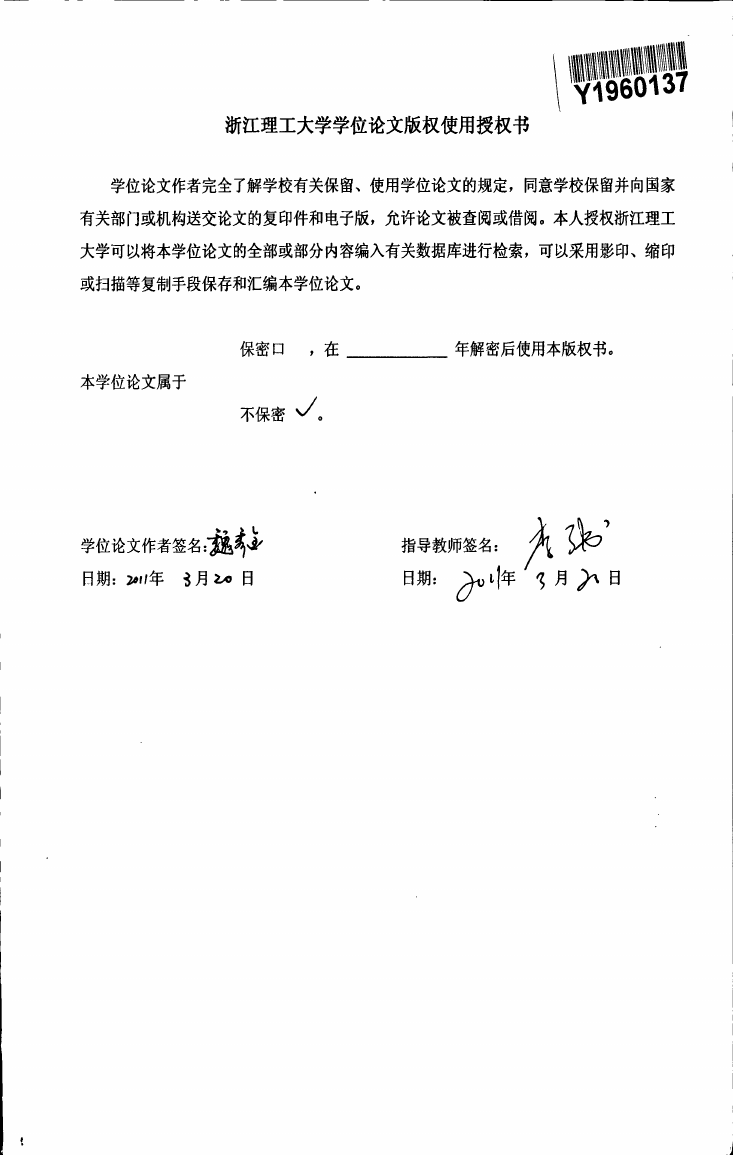
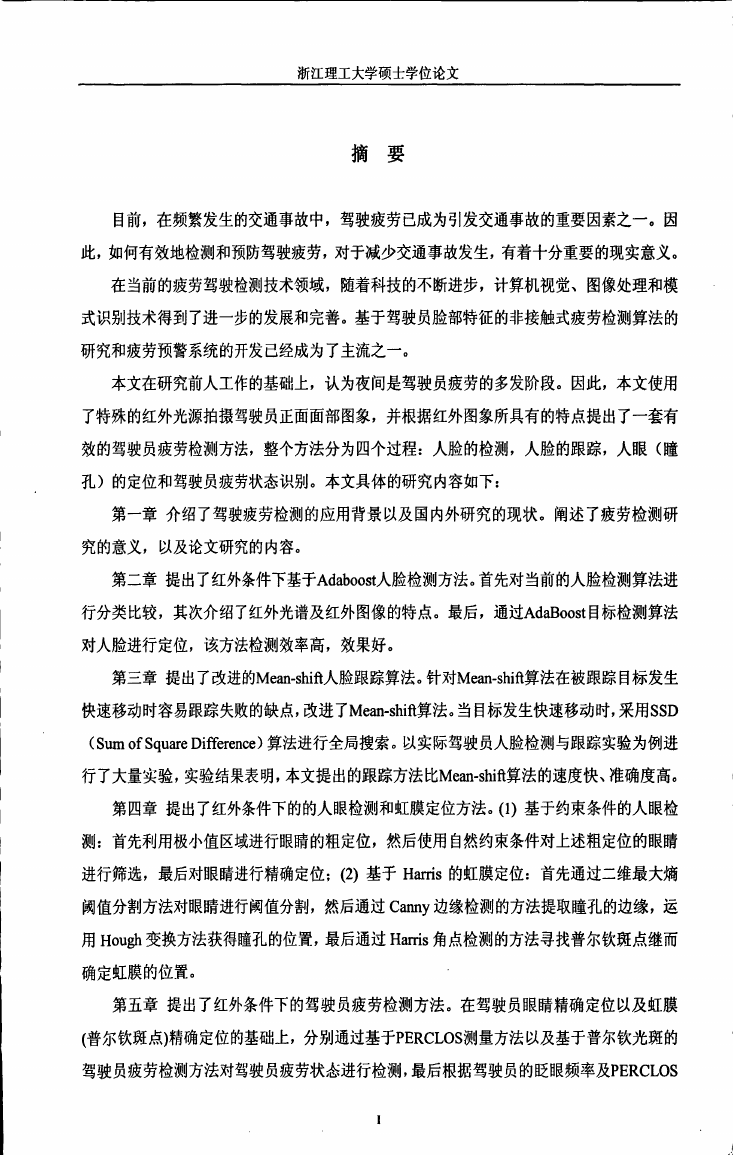
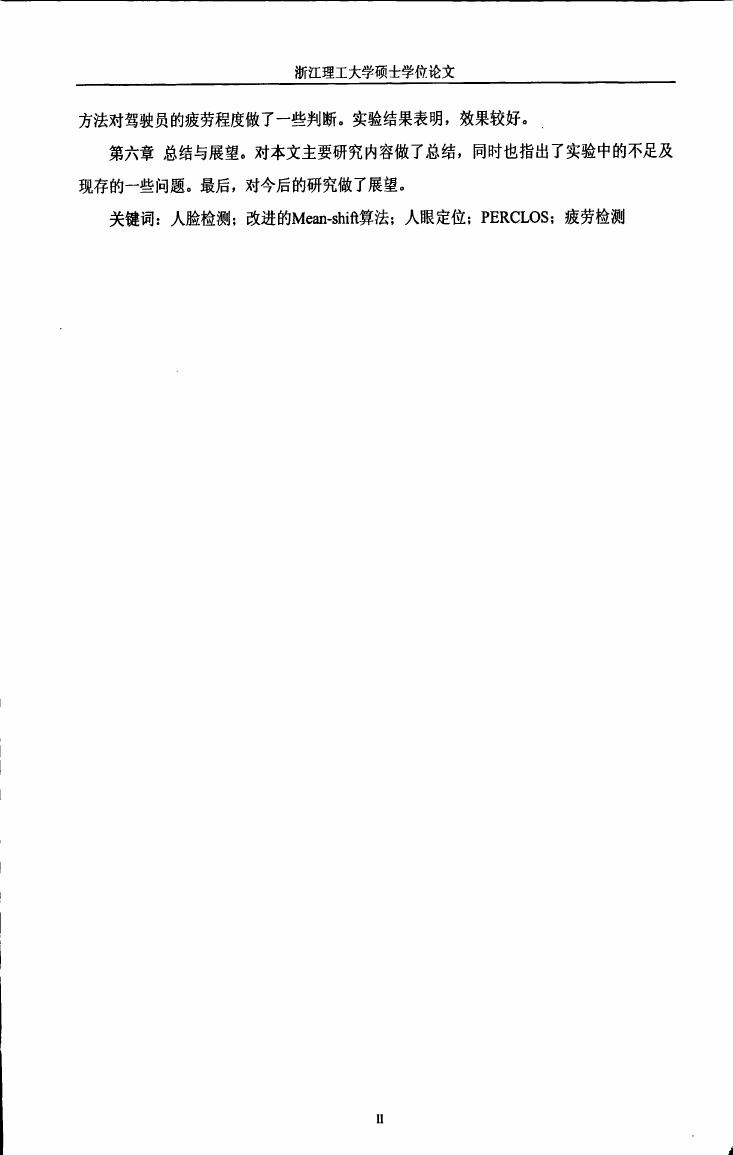
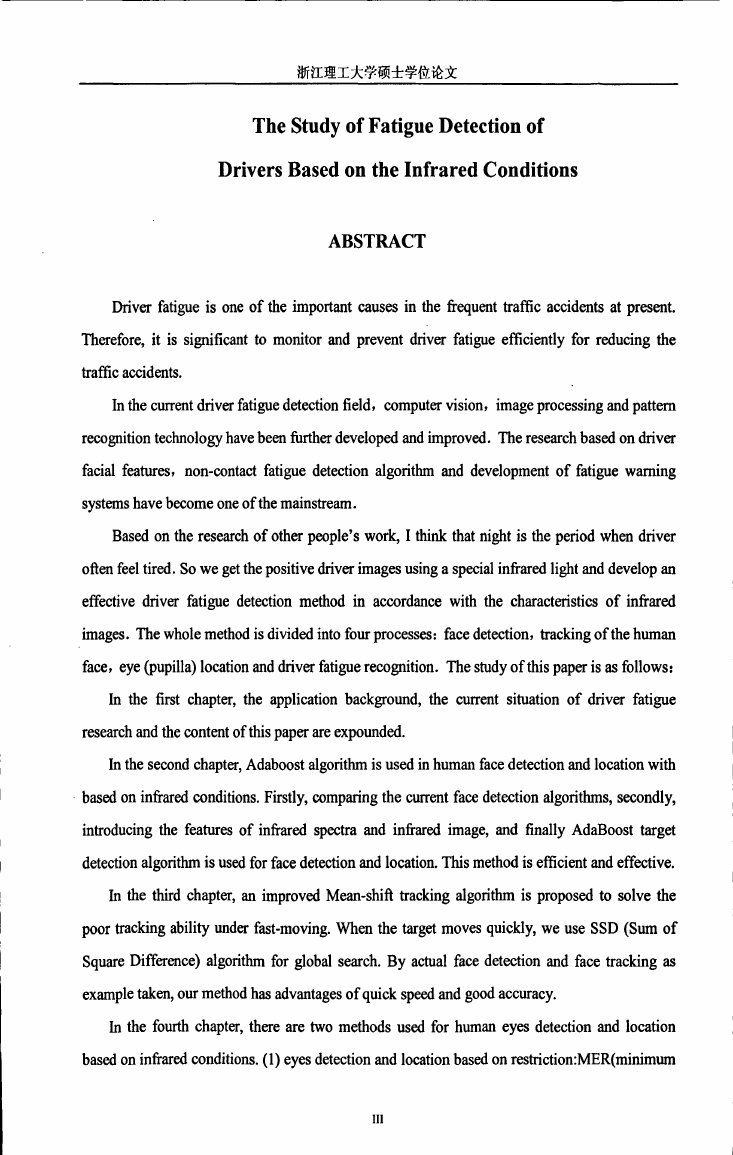


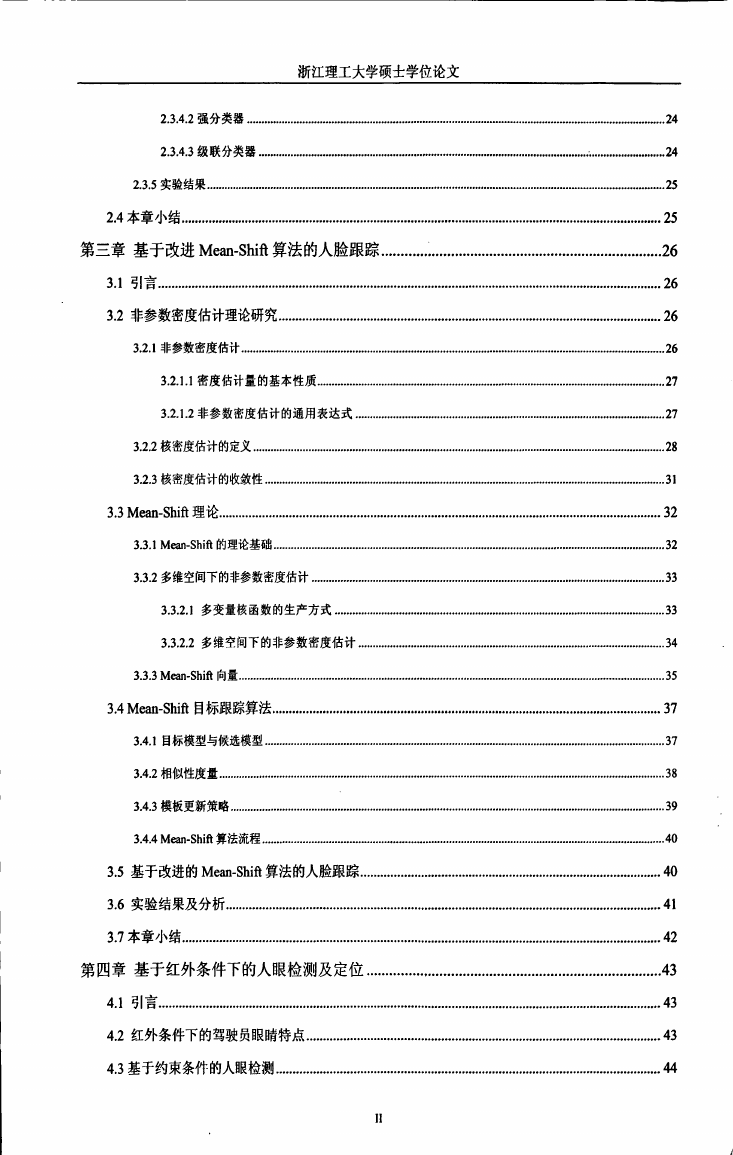








 2023年江西萍乡中考道德与法治真题及答案.doc
2023年江西萍乡中考道德与法治真题及答案.doc 2012年重庆南川中考生物真题及答案.doc
2012年重庆南川中考生物真题及答案.doc 2013年江西师范大学地理学综合及文艺理论基础考研真题.doc
2013年江西师范大学地理学综合及文艺理论基础考研真题.doc 2020年四川甘孜小升初语文真题及答案I卷.doc
2020年四川甘孜小升初语文真题及答案I卷.doc 2020年注册岩土工程师专业基础考试真题及答案.doc
2020年注册岩土工程师专业基础考试真题及答案.doc 2023-2024学年福建省厦门市九年级上学期数学月考试题及答案.doc
2023-2024学年福建省厦门市九年级上学期数学月考试题及答案.doc 2021-2022学年辽宁省沈阳市大东区九年级上学期语文期末试题及答案.doc
2021-2022学年辽宁省沈阳市大东区九年级上学期语文期末试题及答案.doc 2022-2023学年北京东城区初三第一学期物理期末试卷及答案.doc
2022-2023学年北京东城区初三第一学期物理期末试卷及答案.doc 2018上半年江西教师资格初中地理学科知识与教学能力真题及答案.doc
2018上半年江西教师资格初中地理学科知识与教学能力真题及答案.doc 2012年河北国家公务员申论考试真题及答案-省级.doc
2012年河北国家公务员申论考试真题及答案-省级.doc 2020-2021学年江苏省扬州市江都区邵樊片九年级上学期数学第一次质量检测试题及答案.doc
2020-2021学年江苏省扬州市江都区邵樊片九年级上学期数学第一次质量检测试题及答案.doc 2022下半年黑龙江教师资格证中学综合素质真题及答案.doc
2022下半年黑龙江教师资格证中学综合素质真题及答案.doc